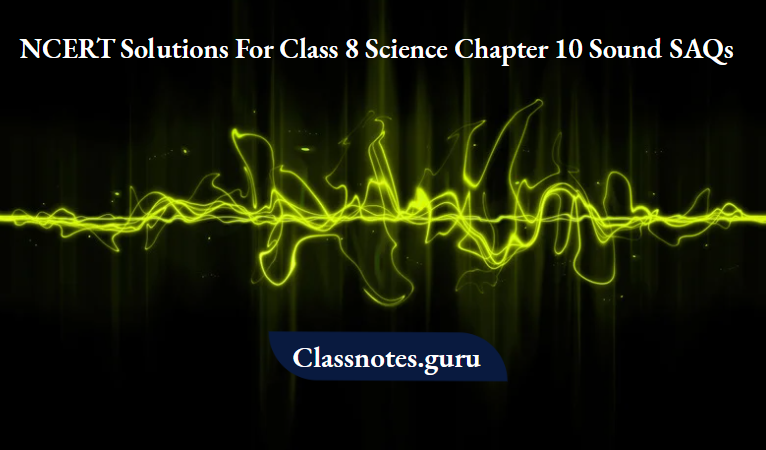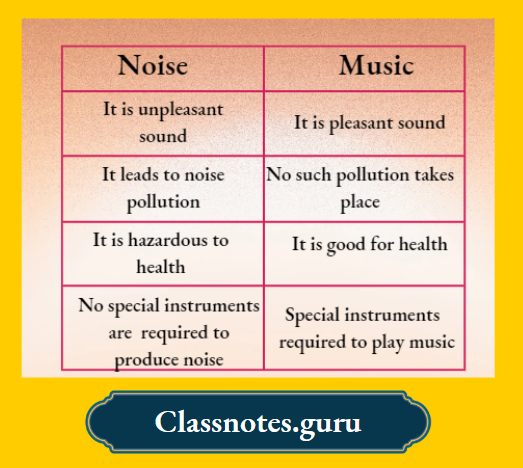NCERT Solutions For Class 8 Science Chapter 10 Sound SAQs

Question 1. Boojho saw a cracker burst at night at a distance from his house. He heard the sound of the cracker a
little later after seeing the cracker burst. Give a reason for the delay in hearing the sound.
Answer:
The light travels faster than sound, so the light from the cracker reaches faster than the sound of the cracker. Speed oflight in air = 3 x 10 8 m/s Speed ofsound in air = 330 m/s
Question 2. Explain the reason for not hearing the screeches of a bat by us.
Answer:
As we know, the audible frequency range for human beings is 20 Hz to 20 kHz. So, it is an obvious thing that the frequency of bats is beyond this range, due to which we are usually unable to hear the screams of a bat.
NCERT Class 8 Science Chapter 10 Sound SAQs
Question 3. Suggest three measures to limit noise pollution in your locality.
Answer:
Some measures to limit noise pollution in our locality are given as
- The industries that produce noise should be set up away from the residential areas.
- The television and the music systems should be run at low volumes.
- The aircraft engines, transport vehicles, industrial machines, and home appliances must be installed with silencing devices.
![]()
Question 4. List three sources of noise pollution in your locality.
Answer:
Sources of noise pollution are
- Horns of vehicles
- Loudspeakers of temples
- Generators running without silencers
Question 5. Briefly explain total hearing impairment.
Answer:
Hearing impairment means a person has damaged hearing ability and cannot hear properly. Some people are born with poor hearing ability. A person with very poor hearing ability is said to be deaf, so deafness is a total hearing impairment.
NCERT Solutions for Sound Chapter 10
Question 6. The sound from a mosquito is produced when it vibrates its wings at an average rate of 500 vibrations per second. What is the period of the vibration?
Answer:
Given, number of vibrations = 500
Time taken =ls
Period time taken/ number of vibrations
= 1/500= 0.002s
Question 7. Identify the part that vibrates to produce sound in the following instruments.
- Dholak
- Sitar
- Flute
Answer:

Class 8 Chapter 10 Sound Short Answer Questions
Question 8. What is the difference between noise and music? Can music become noise sometimes?
Answer:
The Differences between noise and music are:

Question 9. List the sources of noise pollution in your surroundings.
Answer:
As we know that. Noise pollution is caused by excessive sound in our surroundings. The sources of such excessive sound are as follows
- Television and transistor radio at high volume
- Sounds of vehicles
- Explosions, including the bursting of crackers, machines, loudspeakers, etc
- Honking of horns
Question 10. Explain in what way noise pollution is harmful to humans.
Answer:
Lack of sleep, hypertension (high blood pressure), and temporary or permanent impairment of hearing are harmful effects of noise pollution.
NCERT Solutions for SAQs on Sound Chapter 10
Question 11. Your parents are going to buy a house. They have been offered one on the roadside and another three lanes from the roadside. Which house would you suggest your parents should buy? Explain your answer.
Answer:
We will suggest to our parents that they should buy a horn, which is three lanes away from the roadside. Taking a house on the roadside means bearing noise pollution, which leads to harmful effects on health.
Therefore, to attain a piece of mind and to avoid noise pollution, it is better to buy a house three lanes away from the roadside.
